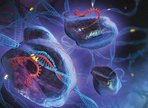Curr Biol:细菌的天然CRISPR免疫防御机制
2015-03-18 佚名 生物谷
近日,刊登在国际杂志Current Biology上的一篇研究论文中,来自埃克塞特大学的研究人员通过研究调查了免疫防御机制的进化如何帮助工业细菌产生抵御病毒感染的特殊免疫力;细菌有许多工业用途,包括产生乳酪和酸奶酪,造纸、产生沼气及合成激素如胰岛素等,然而病毒的感染往往会大大降低细菌对工业上的应用价值。 Edze Westra教授指出,我们的研究揭示,细菌感染的风险可以帮助确定其所采用的免疫防御
近日,刊登在国际杂志Current Biology上的一篇研究论文中,来自埃克塞特大学的研究人员通过研究调查了免疫防御机制的进化如何帮助工业细菌产生抵御病毒感染的特殊免疫力;细菌有许多工业用途,包括产生乳酪和酸奶酪,造纸、产生沼气及合成激素如胰岛素等,然而病毒的感染往往会大大降低细菌对工业上的应用价值。
Edze Westra教授指出,我们的研究揭示,细菌感染的风险可以帮助确定其所采用的免疫防御的类型,而这种天然产生的机制或许可以被用于武装细菌来利用免疫力抵御病毒的攻击;当研究者将细菌暴露于噬菌体进行一系列实验后发现,当细菌暴露于大量相同类型的噬菌体后,细菌会通过修饰其细胞壁来进化出一种持久的免疫防御机制,不可逆的防御机制往往会对细菌的长期健康带来负面的影响。
当细菌暴露于低浓度相同类型的噬菌体时就会诱发产生一种短暂的防御机制,即细菌利用一种名为CRISPR免疫防御机制来抵挡噬菌体的侵袭,在病毒不存在时CRISPR免疫防御机制会处于休眠状态以便细菌在需要的时候被诱发,而这种防御机制对细菌的长期健康影响较小,或许可以更加适合在细菌的商业应用中使用。
类似于疫苗作用的原理,细菌会被预装上CRISPR系统来应对多种不同的噬菌体,这对于细菌的健康非常重要,同时也可以保证工业细菌的产品数量和质量;CRISPR可以通过将病毒的遗传信息整合入细菌的DNA中来发挥作用,从而在细菌细胞中形成代谢病毒序列的遗传数据库,进而在病毒感染过程中来有效识别病毒;如果病毒感染威胁到了细菌细胞,CRISPR免疫系统就会帮助细菌来破坏入侵病毒的基因组。
最后研究者表示,寄生虫的暴露或许也是自然界中驱动永久性和可诱导性防御机制的关键因子,生活在较大群体或富含寄生虫环境中的有机体或许更易于进化出持久性的防御机制,而在低水平寄生虫环境中则更易于进化出可诱导的防御机制。
本文由生物谷编译整理:
Parasite Exposure Drives Selective Evolution of Constitutive versus Inducible Defense
Edze R. Westra5, Stineke van Houte5, Sam Oyesiku-Blakemore, Ben Makin, Jenny M. Broniewski, Alex Best, Joseph Bondy-Denomy, Alan Davidson, Mike Boots, Angus Buckling
In the face of infectious disease, organisms evolved a range of defense mechanisms, with a clear distinction between those that are constitutive (always active) and those that are inducible (elicited by parasites) [ 1 ]. Both defense strategies have evolved from each other [ 2 ], but we lack an understanding of the conditions that favor one strategy over the other. While it is hard to generalize about their degree of protection, it is possible to make generalizations about their associated fitness costs, which are commonly detected [ 3–5 ]. By definition, constitutive defenses are always “on,” and are therefore associated with a fixed cost, independent of parasite exposure [ 4, 5 ]. Inducible defenses, on the other hand, may lack costs in the absence of parasites but become costly when defense is elicited [ 6 ] through processes such as immunopathology [ 7 ]. Bacteria can evolve constitutive defense against phage by modification/masking of surface receptors [ 8, 9 ], which is often associated with reduced fitness in the absence of phage [ 10 ]. Bacteria can also evolve inducible defense using the CRISPR-Cas (clustered regularly interspaced short palindromic repeat, CRISPR associated) immune system [ 11 ], which is typically elicited upon infection [ 12–14 ]. CRISPR-Cas functions by integrating phage sequences into CRISPR loci on the host genome [ 15 ]. Upon re-infection, CRISPR transcripts guide cleavage of phage genomes [ 16–20 ]. In nature, both mechanisms are important [ 21, 22 ]. Using a general theoretical model and experimental evolution, we tease apart the mechanism that drives their evolution and show that infection risk determines the relative investment in the two arms of defense.
本网站所有内容来源注明为“梅斯医学”或“MedSci原创”的文字、图片和音视频资料,版权均属于梅斯医学所有。非经授权,任何媒体、网站或个人不得转载,授权转载时须注明来源为“梅斯医学”。其它来源的文章系转载文章,或“梅斯号”自媒体发布的文章,仅系出于传递更多信息之目的,本站仅负责审核内容合规,其内容不代表本站立场,本站不负责内容的准确性和版权。如果存在侵权、或不希望被转载的媒体或个人可与我们联系,我们将立即进行删除处理。
在此留言








#Biol#
71
#Bio#
63
#CRISPR#
101